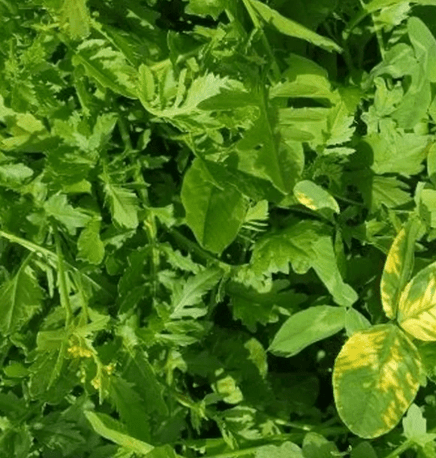Manganese
Nitrogen applications were reduced 33% in the first year without compromising pasture growth which was much better as clover, formerly hard to find, returned. Yellow creeping cress was also rampant. It reduced during the first 12 months. This photo captures white clover and yellow creeping cress, one ascending, the other decreasing. A release of excess manganese can be seen in the clover. That is a side effect of the chemistry as the soil readjusts from an oxidised to a reduced state. (Mn and some other nutrients are more available when reduced.) This reaction is not necessarily to chemistry alone, but also to weather and other complex conditions. The effect is only temporary as biology adapts to changing circumstances.
Manganese accelerates seed germination and early maturity of crops; it is important for nitrogen metabolism. Mn becomes more available at low pH - toxicity can be a problem. High iron or phosphorus can tie up manganese. When K and Na base saturation together exceed 10%, then manganese uptake is blocked.
Found in the mitochondria, it is key component of energy metabolism - may be linked to Chronic Fatigue Syndrome. Critical in cartilage formation and neurotransmitter synthesis (Alzheimer’s is linked to a decline in production of acetyl choline – a key neurotransmitter).
Ruminant levels range from 75-200 ppm of the ration. Nuts, whole grains and black tea are rich in manganese. Deficiencies may lead to infertility in animals and humans. Manganese is required for growth, bone formation and it is also an enzyme activator. Symptoms of manganese deficiency include decreased signs of oestrus and poor conception. A deficiency may manifest as ‘knuckled under’ legs in new born calves, or an excess of bull calves. Take-all in wheat is Mn deficiency.
Sources of manganese include trace mineralised salt, licks, and commercial supplements. Apply manganese sulphate to the soil to maintain a minimum of 75 ppm, building to an optimum of 125-250 ppm. However, do not allow Mn to exceed iron levels, maintaining at least a 5 ppm gap between the two. Mn over (or too close to) Fe will cause the iron to oxidize in the leaves, leading to Fe deficiency.


